Unit – 4
Laplace transforms and properties
Q1) Write equation for given waveform


A1)


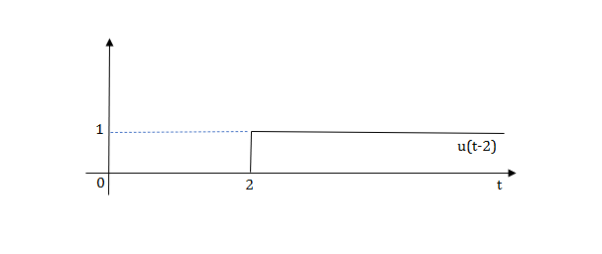

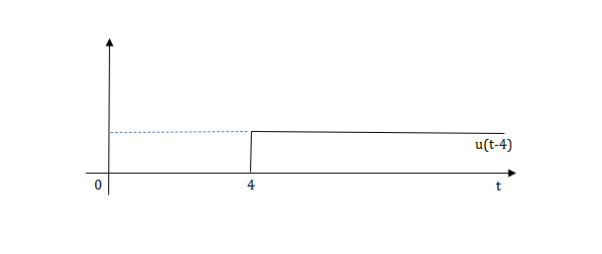

The final equation is=u(t)+u(t-1)+u(t-2)+u(t-3)-4u(t-4)
As the waveform is stopped at t=4 with amplitude 4,so we have to balance that using -4u(t-4).
Q2) Write the equation for the given waveform?

A2) Calculating slope of above waveform
Slope for (0,0) and (1,2)
a1 slope= =2
=2
a2 slope= =-4
=-4

a3 slope =4 and a4= -2


At t=1 slope changes from 2 to -4 so we need to add -6r(t-1) to 2r(t) to get the slope of -4.

At t=1.5 slope changes from -4 to 4 so adding 8r(t-1.5) to get slope of 4

At t=2 slope changes from +4 to -2 so we add -6r(t-2). But we need to stop the waveform at t=3. Hence, we have to make slope 0. Which can be done by adding +2r(t-3). Final equation is given as 2r(t)-6r(t-1.5) +8r(t-1.5)-6r(t-2) +2r(t-3)
Q3) For given RL circuit find the differential equation for current i?

Fig 1 Series RL circuit
A3) After switch is closed applying KVL
 =0
=0
This is first order homogeneous differential equation so
 dt
dt
Integrating both sides
Ln i=  t+K
t+K
Taking antilog of both sides
i=k
At t=0
i(0)= =I0
=I0
 =ke0
=ke0
The particular solution is given as
i=  for t≥0
for t≥0
= for t<0
for t<0
Q4) Find IL(0) for the given circuit below
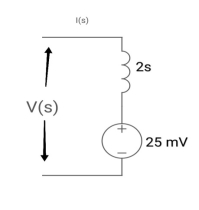
A5) From above circuit
L = 2H
LiL (0) = 25 mv
IL (0) = 12.5 m A
Q5) Find value across capacitor?

A5) From above circuit we can write
1/cs = 2/s
C=1/2f
Vc (0)/s = 0.25v/s
Vc(0)= .25v
Q6) Find voltage across capacitor?

A6) 1/cs = 1/2S
C=2F
CVc (0) = 0.02
Vc(0)= 0.01V
Q7) For the following circuit shown below
(a) switch is at before moving to position = at t= 0, at t= 0+, i1(t) is
(a) –V/2R (b) –V/R (c) – V/4R

A7)
I1(t) L.T I1(s)
I2(t) L.T I2(s)
Then express in form
[ I1(s)/I2(s)] [::] = [:]
Drawing the ckl at t = 0-
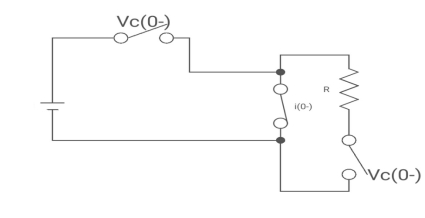
:. The capacitor is connected for long
Vc1(0-)= V
iL(0-) =0
Vc2(0-)=0
At t= 0+


i1 (0+) = -V/2R
For t>0 the circuit is

Apply KVL
-R i1(t) -1/c  dt -L
dt -L =0
=0
Also, we can deduce i1(t)- i2 (t) = iL(t)
-Ri1(t) -1/c  - L
- L = 0
= 0
-RI1(s)-[ -
- ]-L[sI1(s)-iL(0-)]=0
]-L[sI1(s)-iL(0-)]=0
- RI1(s)- -
-  -s L I2(s)=0
-s L I2(s)=0
 - s L I2(s)= -
- s L I2(s)= -  (1)
(1)
Again
-Ri2(t) ) -1/c  dt -L
dt -L =0
=0
-Ri1(t) -1/c  - L
- L = 0
= 0
Taking Laplace Transform
-RI2(s)- [ -
- ]- L[s IL(s)- iL(0-)]=0
]- L[s IL(s)- iL(0-)]=0
-RI2(s)-  -
- Ls[ I1(s)- I2(s)]=0
Ls[ I1(s)- I2(s)]=0
 - s L I1(s)=0 (2)
- s L I1(s)=0 (2)
Hence in matrix representation

 =
= 
Q8) All initial conditions are zero i(t) L.T, I(s), then find I(s)?

A8) Drawing Laplace circuit

(2+S) 11 2/S
Zeq = [(2+S)2/S]/[2+S+2/S]=[2(S+2)]/[S2+2s+2]
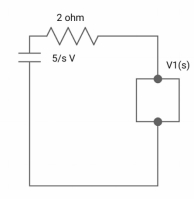
V1(s) = [5/S{2(S+2)/S2+2S+2}]/[2+{2(S+2)/ S2+2S+2}]
V1(s) = [5(S+2)/S]/[S2+ 3S +4]
I(s) = V1(s)/(S+2) = (5/S)/(S2+35+4)
Q9) The switch is at before moving to position = at t= 0, at t= 0+, i1(t) is
(a) –V/2R (b) –V/R (c) – V/4R (d) 0
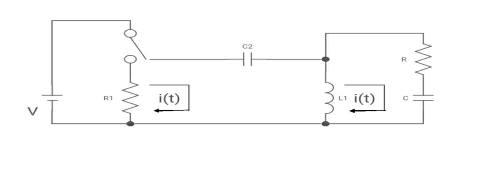
A9)
I1(t) L.T I1(s)
I2(t) L.T I2(s)
Then express in form
[ I1(s)/I2(s)] [::] .[:]
Drawing the ckt at t = 0-

:. The capacitor is connected for long
Vc1(0-)= V
iL(0-) =0
Vc2(0-)=0
At t= 0+


Fig 2 Circuit at t=0+
i1 (0+) = -V/2R
For t>0 the circuit is

Fig 3 KVL in Circuit
Apply KVL
-R i1(t) -1/c  dt -L
dt -L =0
=0
Also, we can deduce i1(t)- i2 (t) = iL(t)
-Ri1(t) -1/c  - L
- L = 0
= 0
-RI1(s)-[ -
- ]-L[sI1(s)-iL(0-)]=0
]-L[sI1(s)-iL(0-)]=0
- RI1(s)- -
-  -s L I2(s)=0
-s L I2(s)=0
 - s L I2(s)= -
- s L I2(s)= -  (1)
(1)
Again
-Ri2(t) ) -1/c  dt -L
dt -L =0
=0
-Ri1(t) -1/c  - L
- L = 0
= 0
Taking Laplace Transform
-RI2(s)- [ -
- ]- L[s IL(s)- iL(0-)]=0
]- L[s IL(s)- iL(0-)]=0
-RI2(s)-  -
- Ls[ I1(s)- I2(s)]=0
Ls[ I1(s)- I2(s)]=0
 - s L I1(s)=0 (2)
- s L I1(s)=0 (2)
Hence in the matrix representation

 =
= 
Q10) All initial conditions are zero i(t) I(s), then find I(s)?

A10) Drawing Laplace circuit

(2+S) 11 2/S
Zeq = [(2+S)2/S]/[2+S+2/S]=[2(S+2)]/[S2+2s+2]

V1(s) = [5/S{2(S+2)/S2+2S+2}]/[2+{2(S+2)/ S2+2S+2}]
V1(s) = [5(S+2)/S]/[S2+ 3S +4]
I(s) = V1(s)/(S+2) = (5/S)/(S2+35+4)
Q11) There is no initial energy stored in this circuit. Find i1(t) and i2(t) for t>0?

A11)

When circuit is closed the network is shown






Q12) Find v0 (t) for t > 0.

A12) Taking Laplace transform of above circuit we have,





Q13) There is no initial energy stored in this circuit. Find vo if ig = 5u(t) mA.

A13) Laplace Transform of above circuit we get


By voltage division we get




Q14) Find value of current i(t) for the given circuit?

A14)
Applying KVL we get

Taking Laplace transform of above equation we get

There is no initial current in inductor before closing the switch so i(0+)=0.


When 

When 

Taking ILT we get

Q15) For the circuit shown below find the value of i1(t) and i2(t) and output voltage across 5 Ohm resistor when the switch is closed also find initial and final values of current?

A15) By KVL we have


Taking LT of above equations, we get


Solving above equation we get



By inverse Laplace transform we get


The voltage across 5 Ohm resistor is

The initial value of i1(t) is

The final value of i2(t) is

The initial value of i2(t) is

The Final value of i2(t) is

Q16) Find the inverse Laplace transform of

A16)





We know that

Hence,

Q17) Find inverse Laplace transform of

A17)





Taking inverse Laplace of above we get


Q18) Find Inverse Laplace transform of

A18)





Q19) Find Inverse Laplace Transform of

A19)







Q20) Write equation for initial and final value theorem?
A20) The initial value theorem

This theorem is valid if and only if f(t) has no impulse functions.
The final value theorem

This theorem is valid if and only if all but one of the poles of F(s) are in the left-half of the complex plane, and the one that is not can only be at the origin.